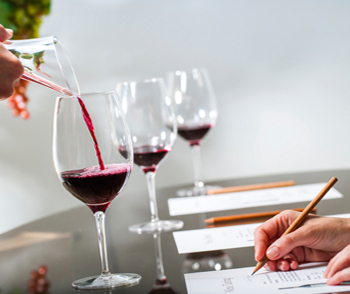With the arrival of Daylight Savings Time, we know that it’s just a matter of weeks now until busy season starts. Let’s get ready to shine with these 10 tips.
- Great Greeting
We only have one chance to make a great first impression, so we need to make sure that our greeting is exceptional. Studies show that if guests aren’t greeted or acknowledged within the first 15 seconds, they typically rate their experience lower. Your first impression is an important one, and recovering from a bad start is almost impossible. Start off every experience on a positive note. If our tasting room is by appointment, we already know who is coming, so we can list the names on a Welcome board they will see as they enter. - Referral Source
The best ice breakers build rapport by finding out what brought our guests to our winery and is a natural part of the initial greeting. Understanding where your guests heard of you – and what specifically brought them in today – helps allocate marketing dollars to those who send qualified guests. Did a nearby winery or restaurant recommend us? Then we can thank our referrers and reciprocate by sending guests to them too. Remember to note the source of each guest so that we have that key information in our database. Perhaps even more important, these relevant open-ended questions set you up to easily build rapport and then tailor the rest of the experience based on your guests’ interests. - On Stage vs. Backstage
On stage refers to the performance concept, where “on stage” is the guest experience – everything the guest sees, hears, touches, smells – and “backstage” is all the things behind the scenes that need to take place in order make sure there is a great on stage performance. Backstage issues are usually physical (i.e., smudged glasses, bathroom that needs servicing) but they can also be verbal (inappropriate attitude or comments in front of the guests). Our tasting experience is an ‘on stage’ performance, and we must rehearse to be ready. Our guests are here for the pixie dust. Don’t spoil it for them by allowing them to see our backstage nuts and bolts. - Service Heart
Does the host really want to be “of service?” Is service in his / her DNA? We can always tell if the person at the bar loves to be with guests. Did we go out of our way to make the visit extra special with some element of surprise and delight relevant to their interests? Did we offer water, a pen, a dump bucket? Let’s make it our personal mission to ensure that each guest leaves with the feeling of WOW! - Build Rapport by Asking Open-Ended Questions
Use relevant open-ended questions to positively profile and understand each guest, and then adjust the experience accordingly. Are they new to wine? How do they enjoy wine? Are they celebrating a special occasion or here on vacation? These are questions that tell us how to best serve each guest. To move customer satisfaction higher (as well as get more, natural sales), more dialogue (less presentation mode) is needed. This can only be done by asking open-ended questions. - Use Analogies & Storytelling
These skills help to educate and entertain guests all at once. Make wine accessible to those who are learning by explaining concepts in terms of something they already understand. For example, we plant roses to act like the canary in the coal mine to warn us of pests in the vines. Analogies make visitors feel comfortable (instead of intimidated) as they learn new things and concepts. Analogies are especially effective for visitors who are new to wine. Storytelling helps to share interesting, relevant things about the wine and winery. The best tasting room performers – the best sales people – are all great story tellers because they weave a good tale. Including stories and analogies engages customers, gains trust, and earns sales. - Sell the Brand First, the Wine Second.
Let’s face it, we all have great juice, so the story of what makes us unique will be the differentiator. Our brand needs to be compelling and unique and it will come alive with great stories. We need to have a bunch of stories that illustrate what our brand is about, so that we don’t risk sounding like we are reading from a canned script by repeating the same story over and over again. Selling the brand and the experience first with compelling stories will help naturally sell the wine and make it more memorable to guests. - Leverage Silent Selling Tools
Non-verbal sales tools facilitate more sales and support our brand standards. Every single guest should receive a list of wines being tasted with descriptors, pricing and room for notes plus a full price list, order form, club brochure and a pen. Wine club brochures and email sign up cards should be staged on the tasting bar and at other locations in the Tasting Room. This will help remind us to talk about these important topics. - Follow Professional Sales Steps
Use features and benefits to sell the wine, the wine club and the email list. A feature is what something is. It’s a factual statement about a product or service and alone won’t usually close the sale. A benefit appeals to the customer’s emotions by conveying what’s in it for the customer, which makes the sale. Don’t save the conversation about these topics until the very end of the experience. Warm them up by planting sales seeds and noticing buying signals throughout the experience. As we pour a wine, we can tell our guests what to pair it with. Food helps us sell when we can offer a wine that pairs beautifully with their favorite dishes. Mention that it’s a club exclusive or club favorite to entice them to sign up. Talk about the great deals sent by email so that they want to sign up for the list. - The Friendly Farewell
We want our guests to leave us with the intention to return and bring their friends, so let’s invite them to come back soon. Manners matter! If our guest has purchased, let’s make sure we thank them, and perhaps carry their purchase out to their car. ‘No problem’ is not an acceptable substitute for ‘you’re welcome.’ Every guest should be given a friendly farewell with a suggestion to come back and visit soon.
Summer will be here before we know it. Are we ready?




